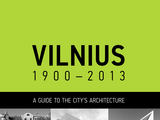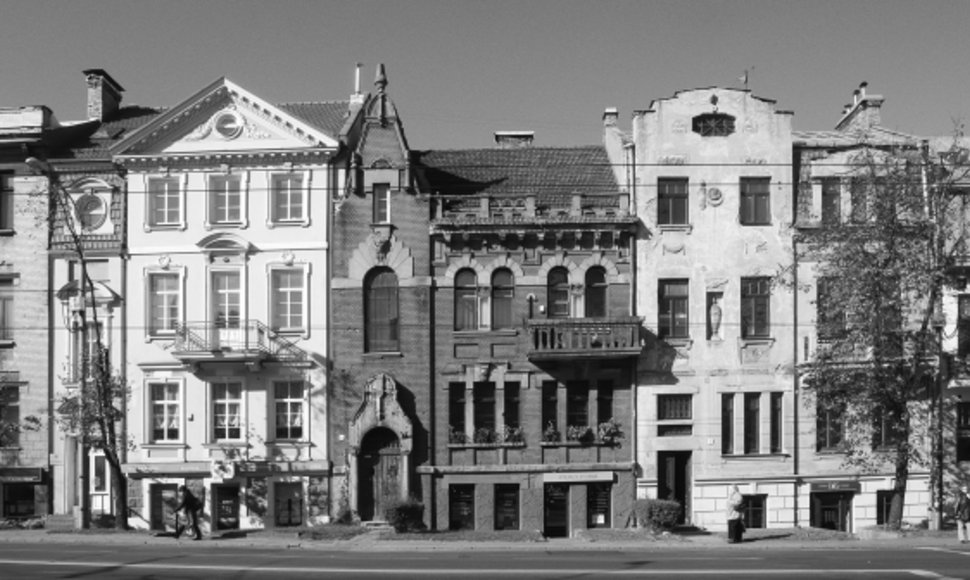 |
| Book cover |
The following is an extract from the English-language publication Vilnius 1900–2013. A Guide to the City's Architecture.
At the dawn of the 20th century, the elegant Central European Sezession style was still in vogue. Architecture later progressed to the stripped-down interwar Modernism of the 1920s and 1930s, and after the Second World War it ventured into the controversial Soviet-imposed Neoclassicism. After ‘totalitarian’ architecture was officially condemned in the mid-1950s, postwar Modernism flourished, particularly in the new residential districts that were built to house the city’s growing population. At the end of the Soviet period, Late Modernism saw a large number of public buildings appear around the city centre.
With the reestablishment of independence in 1990, and with the consequent changes that took place in the economy and in society, Vilnius experienced yet another wave of urbanisation. Private houses were built again, filling the city to the limits, and a spectacular steel and glass city centre took shape on the right bank of the River Neris.
https://www.facebook.com/VilniusArchitectureGuide
Tomas Grunskis. Notes on the Development of the City of Vilnius
Vilnius has often been written about, and in many different ways. The amount of writing and the repeated reflections on history and culture only serve to emphasise the uniqueness of the city, and the fact that the full depths of its history and culture have not been entirely uncovered. Whenever we think about the city, sometimes called the Athens or the Jerusalem of the North, we feel its strange mysteriousness, and the sensation that a lot of it has been hidden from us, and a lot of its faces are yet unknown. I do not mean just historical facts; more the story of its everyday life, which makes the city our own, and allows us to understand not only its surface, but its history too. It is a good idea to start talking about Vilnius in the same way that Vladas Drėma finished his most prominent work, Dingęs Vilnius (Lost Vilnius, 1991), probably the best treatise of all time on the development of its architecture. In the last chapter, entitled ‘Reflections’, Drėma writes:
‘Vilnius was beautiful, Vilnius is beautiful, Vilnius hopefully will always be beautiful [...] Beauty is universal, but its manifestations, its criteria and perception are different, depending on the culture of the person, and his living conditions, which are altered by history and the time. Vilnius was beautiful in the past in one way, now it is beautiful in another, and it will, hopefully, be beautiful in some other way in the future [...] It is no secret that now, by applying industrial constructions and a unified type of building, and striving for economic indices, there is a danger of a city becoming uniform and losing its own face, which locals are already used to, and which is passionately searched for by tourists [...] The cultural and artistic heritage of old cities is also cherished for its intrinsic architectural value, for the context within the cultural values of other ages, and for the opportunities to follow the historical development of these artistic values, to reveal their distinctiveness and their transitions (V. Drėma, Lost Vilnius, Vaga, 1991, p. 392).
Drėma’s thoughts about the threat of losing the uniqueness of the city’s face (with Soviet developments in mind) and about civilised barbarians, which he wrote more than two decades ago, do not seem outdated, radical or inappropriate, even today. Such reflections, and the care in preserving Vilnius’ face and its identity, are always appropriate, and are apparently repeated by every generation, attempting to find its own relationship with the city. Naturally, the cityscape changes with the city’s development and its society. The concerns discussed here are also natural, because each epoch either enriches the city or impoverishes it. And there is no middle ground. Big changes to the cityscape and its society always have supporters and enemies. Equally natural and intentional, already traditional (if slightly romantic), is the tendency to depict Vilnius by presenting its greatest asset: the city stands on seven hills, in an old river valley, in tune with nature. This gives it its strange naturalness and mysterious lighting. On the one hand, the quality of this view has always made it unique. On the other hand, being between Eastern and Western Europe, on a crossroads between these two worlds, Vilnius has always been culturally and ethnically varied. Signs of globalisation have always been apparent. Throughout its history, it has either been the last outpost of the culture of Western Europe, or the East European city of Western culture. Because of transformations of sociocultural conditions, in whatever context it has been, it has always acquired traits of that context, sometimes becoming a multicultural West European city, sometimes the distant province of an empire. But all these situations have left their symbols and historical marks, and this has made Vilnius multinational and dear to everyone. That is why it is a city which historically has been disconnected from nationalism and its sentiments. Ever since the times of Gediminas, it has developed as multinational, open to all, and has therefore always been varied, colourful and interesting to visitors.
The Urbanisation of Vilnius
Both the cityscape and the content of Vilnius have changed many times. As its appearance changes, the layers of its content change too, and, of course, its identities, which are still pondered on and described. Both its volume and its composition have changed, and these changes, its urbanistic transformations, are referred to here as urbanisation. This term should be understood more broadly than usual, in a cultural sense more than a technical one. Thus, over time, the cycles of Vilnius’ urbanisation and their intensity are very like the laws of waves in physics. (This is why we call it waves of urbanisation.) There have been three prominent waves of urbanisation, and each one is interesting and unique in its own way.
(to be continued)












